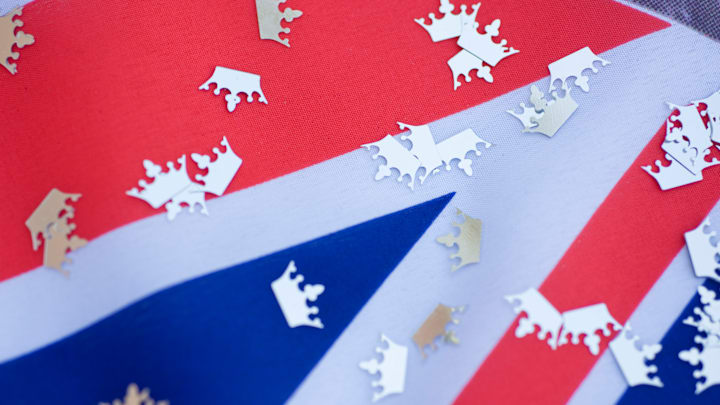The noble titles of duke, duchess, earl, countess, and so on are relics of the peerage system, a hierarchy that conferred power to people in ye olde British political and landowning order. Members of the peerage system, called “Peers,” were the monarch’s vassals: They swore loyalty to the king or queen in exchange for money or land. In feudal times, these titles—and the jobs that came with them—were passed down to male heirs and their spouses.
Nowadays, it’s easy to wave off these fancy titles as antiquated symbols of a dead political system. But the truth is, hereditary peers still hold significant political power in England. For centuries, peers (all male until 1958)—called “Lords”—occupied the upper house of British Parliament: the aptly titled “House of Lords.” In 1999, a bill weakened their power considerably. Yet 92 hereditary peers still sit in the House of Lords, drafting and reviewing legislation.
Let’s dive into how the system works.
- King and Queen
- Duke and Duchess
- Marquess and Marchioness
- Earl and Countess
- Viscount and Viscountess
- Baron and Baroness
- Life Peer
King and Queen

At the top, of course, sits the king or queen. There are some special naming rules for the head of state. If a king sits on the throne, his wife is called the “queen consort.” However, if the queen is running the show, her husband has no automatic right to a title. Prince Philip was a Prince of Greece, but renounced his title before marrying Elizabeth, so when Elizabeth became queen in 1952, he was properly referred to as the Duke of Edinburgh. Despite constant press references to him as “Prince Philip,” that title only became official in 1957, when Elizabeth II conferred “the style and titular dignity of a prince” on her husband. The sovereign is considered the “fount of honour” and has the exclusive right of conferring titles. All ranks must first meet his or her approval.
Duke and Duchess

The highest peerage titles are duke and duchess. Traditionally, the duke was the sovereign ruler of a duchy or dukedom (a large swath of land) and the title is frequently, but not always, given to a member of the royal family. (That’s why you see royals flaunting territorial titles such as the “Duke of Cornwall” or “Duchess of Cambridge.”) Current dukes will pass their titles down to their male heirs.
You May Also Like ...
- 8 Royals Who Renounced Their Titles
- Why Princess Elizabeth Was Almost Never Queen Elizabeth II at All
- 20 Words and Phrases Every British Royal Family Enthusiast Should Know
Add Mental Floss as a preferred news source!
Marquess and Marchioness

The step below duke is marquess or marchioness. The title was traditionally given to a duke-like noble who oversaw a Welsh or Scottish march, or border territory. Like a duke, a marquess held responsibility over a large mass of land. Unlike a duke, however, a marquess had the extra responsibility of defending this frontier from invaders. These titles are generally inherited by the first-born son.
Earl and Countess

Under that is earl and countess. Originally, an earl was a do-it-all governor-judge-cop-taxman. He could be the administrator of a shire, province, or county. He might also be responsible for collecting taxes and fines and playing the part of judge or sheriff. He was often entitled to receive every “third penny”—that is, one third!—of all judicial revenues. The title is hereditary, though it’s not unheard of for the reigning monarch to give a former prime minister an earldom.
Viscount and Viscountess

One step below that is viscount and viscountess. Back in feudal days, the viscount was exactly what it sounds like: a “vice count,” a deputy or lieutenant who served the earl. The title is often given to the children of earls, however the rank may overlap with other titles: A handful of dukes and earls pull double-duty as viscounts. The title has also been awarded to outgoing Speakers at the House of Commons.
Baron and Baroness

The lowest rank in the traditional peerage system is that of baron and baroness. The baron acted as the sovereign's "tenant-in-chief" and possessed a number of fiefs—basically a subdivision of a county. A baron’s rank, as well as his land, was usually passed down to an heir. (From 1876 to 2009, prominent lawyers and judges were eligible for the title of baron to create the equivalent of a Supreme Court, but that practice was repealed when a real Supreme Court began.)
Life Peer

If you’re not a noble, you still have a chance at earning one of their titles without having to go through the trouble of a royal wedding. In 1958, legislation introduced a new rung in the peerage ladder: life peer. Heredity has nothing to do with these titles. This distinction, which is nominated by the Prime Minister and appointed by the Crown, has been awarded to prominent doctors, professors, veterans, business owners, and farmers. And while you can’t pass your title down to your children, the position does land you a comfy seat in the House of Lords. So get cracking on building that resume!
A version of this story originally ran in 2018; it has been updated for 2025.
